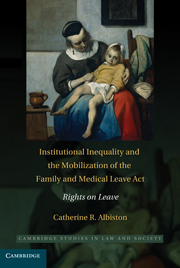Book contents
- Frontmatter
- Contents
- Preface
- Acknowledgments
- 1 Institutions, Inequality, and the Mobilization of Rights
- 2 The Social Institution of Work
- 3 Institutional Inequality and Legal Reform
- 4 Mobilizing the FMLA in the Workplace: Rights, Institutions, and Social Meaning
- 5 Mobilizing Rights in the Courts: The Paradox of Losing by Winning
- Conclusion
- Appendix A
- Appendix B
- References
- Index
- Cambridge Cultural Social Studies
4 - Mobilizing the FMLA in the Workplace: Rights, Institutions, and Social Meaning
Published online by Cambridge University Press: 05 October 2010
- Frontmatter
- Contents
- Preface
- Acknowledgments
- 1 Institutions, Inequality, and the Mobilization of Rights
- 2 The Social Institution of Work
- 3 Institutional Inequality and Legal Reform
- 4 Mobilizing the FMLA in the Workplace: Rights, Institutions, and Social Meaning
- 5 Mobilizing Rights in the Courts: The Paradox of Losing by Winning
- Conclusion
- Appendix A
- Appendix B
- References
- Index
- Cambridge Cultural Social Studies
Summary
TO THE EXTENT WORKERS INVOKE RIGHTS IN WORKPLACE interactions and negotiations about leave, workplaces are an important place to study how institutions shape the way FMLA rights operate in practice. How do workers who need leave but encounter resistance from their employer make sense of their situations? How do they view conflict over leave and evaluate their choices about how to respond? How do institutionalized expectations and norms about work give meaning to these workplace interactions? More broadly, how do these institutional processes inhibit or facilitate social change through law?
These questions can be addressed, in part, by interviewing workers who negotiated contested leaves in the workplace but did not take their disputes to court. This approach serves two broad theoretical objectives. The first is to examine how established power dynamics and social meanings in the workplace shape informal rights negotiations. Understanding this process is important because the vast majority of disputes never make it as far as a formal complaint (Miller & Sarat 1981), yet most studies of rights mobilization focus on litigation or collective action (see, e.g., Burstein 1991; Burstein & Monahan 1986; McCann 1994; Rosenberg 1991; Schultz 1990), rather than on more informal ways of using rights.
- Type
- Chapter
- Information
- Institutional Inequality and the Mobilization of the Family and Medical Leave ActRights on Leave, pp. 149 - 186Publisher: Cambridge University PressPrint publication year: 2010



